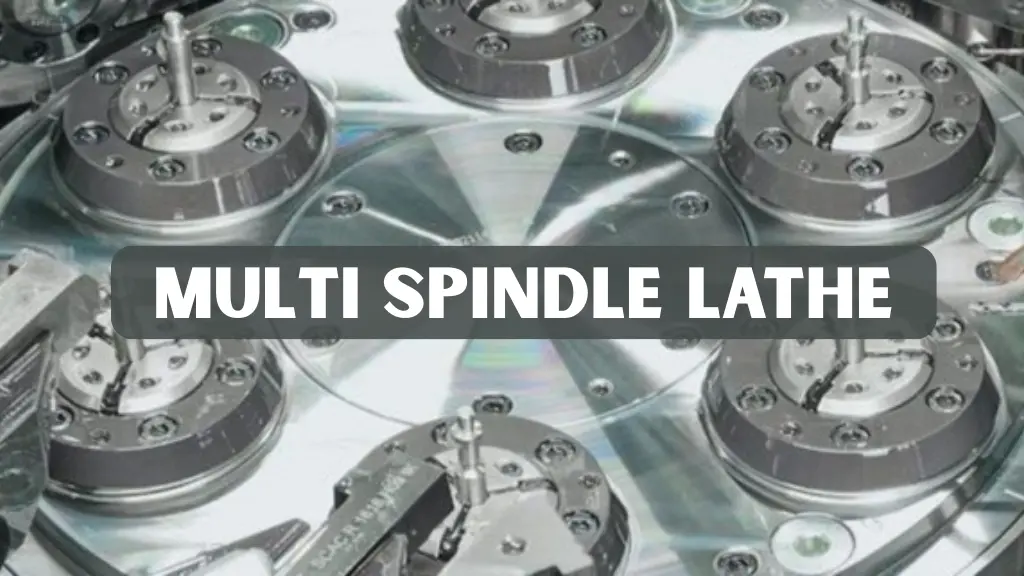In today’s competitive manufacturing landscape, efficiency, accuracy, and consistency are crucial for success. For factories and workshops aiming to maximize output while maintaining high-quality standards, the multi spindle lathe has become a transformative solution. Unlike conventional single-spindle lathes that handle one workpiece at a time, multi-spindle can machine multiple parts simultaneously, significantly increasing productivity without compromising precision.
In this comprehensive guide, we will explore the workings, types, benefits, applications, and maintenance practices of these machines, helping manufacturers and machinists make informed decisions about integrating this technology into their production lines.
What is a Multi Spindle Lathe?
A multi spindle lathe is a specialized machine designed to perform several turning operations on multiple spindles at once. Unlike a traditional lathe, which processes one component per spindle, a multi spindle machine allows several workpieces to be machined simultaneously. This parallel processing reduces cycle time and increases efficiency, especially for high-volume production runs.
These machines feature multiple spindles, typically ranging from two to twelve. Each spindle is equipped with automated tooling that can perform operations such as turning, threading, or drilling. High precision is a hallmark of spindle lathes, ensuring that every workpiece maintains consistent tolerances. Modern versions often incorporate computer numerical control (CNC) systems to enhance accuracy and flexibility, allowing operators to switch between different workpieces and designs with minimal downtime.
How the Machine Operates
The operation of these advanced lathes revolves around the synchronization of multiple spindles. The process begins with loading the workpieces into the spindles, which can be done manually or via automated bar feeders for continuous production. Once loaded, each spindle rotates, performing its designated operation. These operations can include turning, drilling, threading, or even milling, depending on the lathe configuration.
An indexing mechanism positions the spindles accurately relative to the cutting tools, allowing for sequential or simultaneous machining. After the components are completed, they are either ejected automatically or removed manually. This synchronized workflow is what allows a multi spindle lathe to complete multiple parts in the time it would take a single-spindle lathe to produce just one, making it ideal for manufacturers looking to increase throughput without sacrificing quality.
Type of Multi Spindle Machines
Multi spindle lathe are available in a variety of configurations to meet different production needs. Cam-operated models rely on mechanical cams to control spindle rotation and tool movement. This traditional design is highly durable and well-suited for repetitive production where consistent tolerances are required, though it is less flexible than CNC alternatives. Cam-operated machines are commonly used in industries producing uniform parts in high volumes, such as fasteners and small automotive components.
CNC variants, controlled through computer numerical systems, offer greater precision and versatility. Operators can program complex designs, adjust tooling positions, and perform multiple operations simultaneously. These machines are ideal for custom components or production lines that require frequent product changes.
Another style is the sliding headstock lathe, in which spindles move along the machine bed to work on long, slender pieces. When paired with CNC control, this setup enables precise threading, drilling, and shaping. Sliding headstock machines are frequently used in the manufacture of medical devices, electronic connectors, and other small, precise components.
When comparing cam-operated machines to CNC versions, the differences become clear. Cam-operated equipment offers simplicity and durability, making it reliable for mass production, while CNC models provide flexibility, higher precision, and easier adaptability for complex designs, making them suitable for modern manufacturing environments.
Advantages of Using This Lathe
The advantages of a multi-spindle turning machine extend well beyond speed. One of the most significant benefits is increased production efficiency. By machining multiple parts simultaneously, manufacturers can achieve higher output without adding additional machines or labor. This efficiency is particularly valuable in high-volume production environments, where every minute of cycle time counts.
Consistent quality is another key benefit. The precision mechanisms built into advanced machining equipment ensure that each workpiece maintains uniform tolerances, reducing errors and improving overall product reliability. Achieving this level of consistency is difficult with manual or single-spindle lathes, where variations are more likely.
Cost savings also make these high-volume production lathes appealing. Automation reduces the need for manual labor, while decreased idle time increases overall return on investment. The ability to perform multiple operations in a single setup eliminates the need for secondary machines, further lowering production costs.
This type of equipment is also highly versatile. It can handle various operations such as turning, drilling, and threading within a single setup and can work with a wide range of materials, from soft aluminum to hardened stainless steel. Such versatility makes it suitable for numerous industries, including automotive, electronics, and medical device manufacturing.
Industrial Applications
These advanced multi-spindle turning machines are commonly used in various industries. They are ideal for high-volume production of small, precise components. In the automotive sector, they are ideal for producing engine parts, shafts, and fasteners, where speed and accuracy are critical. The electronics industry also benefits from these machines for creating connectors, pins, and terminals, offering consistent quality and precise tolerances that are essential for small-scale components.
Medical device manufacturers rely on this type of equipment to produce surgical screws, implants, and precision instruments, while aerospace companies use them for high-tolerance aircraft components that ensure safety and performance. Even general manufacturing industries depend on multi-spindle systems to produce precise parts for machinery, equipment, and specialized tools. The versatility of these machines allows companies to handle a wide variety of materials efficiently.
By providing fast, consistent, and accurate machining, these advanced production lathes give industries a competitive edge where both quality and volume are crucial. Their ability to perform multiple operations simultaneously reduces cycle times and labor costs, helping manufacturers meet tight deadlines without compromising standards. For businesses aiming to optimize efficiency and maintain precision, these machines are an indispensable asset.
Selecting the Right Machine
Choosing the right machine involves considering several factors. Production volume is critical; high-volume operations benefit most from machines that can handle multiple spindles efficiently. The type of material being machined is an important consideration. Different metals and composite materials require the correct tooling and machine capabilities to ensure precision and efficiency.
Automation needs will influence whether a cam-operated or CNC machine is most suitable. Manufacturers requiring flexibility, complex designs, or frequent product changes often prefer CNC models for their versatility and precision. Maintenance and support should also be factored in, as availability of spare parts and reliable service are crucial for minimizing downtime. Reputable brands like TSINFA and PT Engineers provide high-quality machines with strong global support networks, helping businesses optimize production with confidence.
Maintaining Peak Performance
Proper maintenance is essential for long-term performance and reliability. Daily checks should include lubricating spindles, inspecting coolant levels, and cleaning away metal chips. Monthly inspections help identify alignment issues, check drive belts, and test indexing mechanisms for smooth operation.
Annual overhauls are recommended to replace worn bearings, recalibrate CNC systems, and verify tool precision. Keeping a detailed maintenance log allows operators to track performance, prevent unexpected downtime, and ensure that the machine continues to operate at peak efficiency. Proper care not only extends the lifespan of a multi spindle machine but also preserves the high precision and consistency required for modern manufacturing.
Case Study: Automotive Manufacturing Success
Smith Solutions, a leading automotive components manufacturer, faced the challenge of producing 10,000 precision shafts per month while minimizing downtime. To solve this, the company implemented an 8-spindle CNC turning system with an automatic bar feeder. This setup enabled multiple components to be machined simultaneously, maintaining consistent quality across every part. The engineering team carefully calibrated the machine to meet strict automotive tolerances.
The results were significant. Production efficiency increased by 250 percent, while tolerances remained precise at ±0.01 millimeters. Labor costs dropped by 40 percent due to automation and optimized workflow. This case illustrates how investing in advanced machining equipment can boost output, improve reliability, and increase profitability in high-volume, precision-focused manufacturing.
Conclusion
The multi spindle lathe is more than just a production tool, it is an investment in efficiency, precision, and quality. From automotive to medical manufacturing, these machines enable high-volume production without sacrificing consistency. By understanding their types, operational benefits, and maintenance requirements, manufacturers can make informed choices that enhance productivity and reduce costs.
For companies seeking a competitive edge in precision manufacturing, investing in a high-volume production lathe is a practical step toward operational excellence. Trusted suppliers like TSINFA provide advanced solutions to help manufacturers maximize throughput and maintain precision.
Frequently Asked Questions
What is the difference between single-spindle and multi-spindle machines?
Single-spindle lathes handle one workpiece at a time, whereas multi-spindle turning machines can process several components simultaneously, significantly improving production efficiency.
Are multi-spindle machines expensive?
The initial investment is higher than that of single-spindle lathes. However, the improvements in production speed and the reduction in labor costs make it worthwhile.
Can these machines handle different materials?
Yes, modern multi-spindle turning equipment can handle metals, plastics, and composite materials. Proper tooling and correct machine parameters are essential to achieve accurate and consistent results.
How is maintenance handled?
Routine maintenance includes lubrication, cleaning, spindle alignment checks, monthly inspections, and annual overhauls to ensure precision and reliability.
Which industries benefit most?
Industries such as automotive, electronics, and medical device manufacturing benefit greatly from these machines. Aerospace and general precision engineering also gain advantages due to their speed, accuracy, and overall efficiency.




